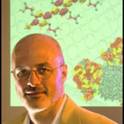Synergistic dipole-dipole and hydrogen-bonding interactions are used to assemble nanostructured materials. Precipitation of a hydrogen-bonding donor-acceptor molecule 8-[[p-[bis(ethyl)amino]phenyl]azo]-isobutylflavin (ABFL) yields nanowires approximately 50-150 nm in diameter and lengths of several millimeters. Precipitation of the non-hydrogen-bonding analog, methylated ABFL (MABFL), generates micrometer-sized hexagonal platelets that are 5-10 microm in length, 1-5 microm in width, and 0.1-0.5 microm thick. The structural similarity of the two molecules allows intermediate morphologies to be formed via co-precipitation. Doping experiments demonstrate efficient control over nanowire length and diameter due to the disruption of the hydrogen bonding within the nanowires.
- dipoles,
- hydrogen bonding,
- nanowires,
- self-assembly
Available at: http://works.bepress.com/vincent_rotello/80/
